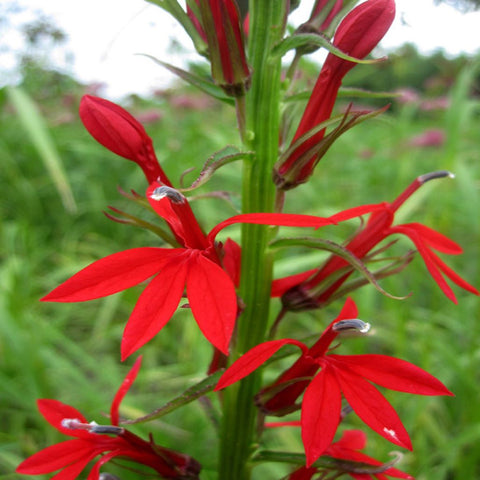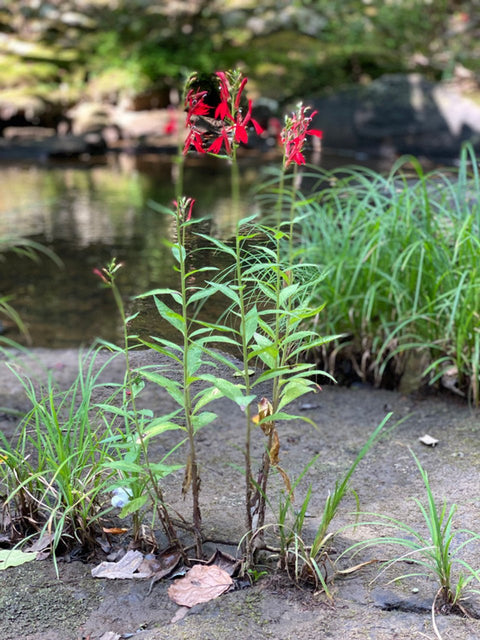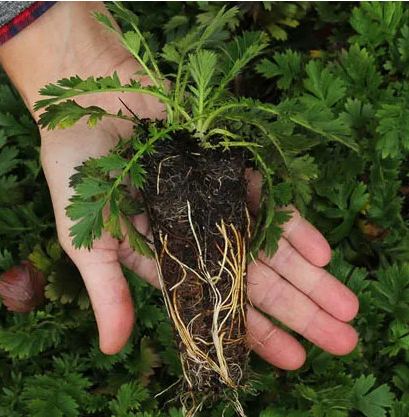


Lobelia Cardinalis - Red Cardinal Flower
Lobelia cardinalis, also called cardinal flower, is a Missouri native perennial that typically grows in moist locations along the edges of ponds and streams. The plant is a member of the Lobeliaceae family and has two leaves on either side of a single stem. The flowers are typically pink and bloom mid-summer with 5-petal blossoms that usually grow 3" long. The plant is a member of the buttercup family and is commonly used in landscaping around water. The flowers can be cut to make a bouquet for Valentine's Day, Mother's Day, and Father's Day that smells faintly like strawberry lemonade. The plant typically blooms once a year from mid-summer through the fall.
1.How to plant lobelia cardinalis
Cut a hole below the soil's surface approximately 12"' broad and deep. Plant into the hole with the pointy end of the rootball facing up and down. Take soil from around the base of the plant and fill in all around it so that the bottom of the plant is level with the soil. Water thoroughly.
2. How to care for lobelia cardinalis
Lobelia cardinalis is low maintenance regarding watering and fertilization requirements, as it can tolerate average moisture levels and dry soil. It can be planted by itself or with multiple other plants in a bed or garden space. The plant prefers to be planted in moist soil but can tolerate sandy and dry soils.
3. WHERE TO GROW LOBELIA CARDINALIS
The cardinal flower needs a particular growing environment to thrive. The plant is intolerant of low temperatures but can tolerate variations in soil moisture, pH, and light requirements which can vary regionally. Therefore, gardeners must adapt their planting strategies to accommodate local conditions and the natural characteristics of the individual species. Although the plant prefers well-drained soil, it will grow in heavier clay soils as long as they are moist.
4. WHY SHOULD HOMEOWNERS AND GARDENERS CONSIDER GROWING LOBELIA CARDINALIS
Lobelia cardinalis is an attractive perennial used in traditional gardens and other landscaping projects. It is combined with other plants in many landscape design applications, as it brightens up dark locations and is used as an ornamental plant in many areas. In addition, the plant provides ground cover along the edges of ponds and water features, which adds a pleasing aesthetic feature to the landscape.
5. How to identify lobelia cardinalis
Lobelia cardinalis is a hardy perennial that can tolerate cold winters and hot summers. The plant has pale green, slightly hairy foliage. The plant branches from the bottom and grows up to 18 inches tall yearly. The plants typically bloom in mid-summer with five petals that grow up to 3 inches long.
6.How to propagate lobelia cardinalis
The seeds can be collected and planted in another part of the garden or pots outdoors until they are ready to be transplanted. Ensure the seedling has adequate moisture by misting it regularly and avoiding overwatering. The plant can withstand some freezes if the soil is not too dry. It prefers temperatures between 50 and 55 degrees Fahrenheit, but it will tolerate winter temperatures of up to 75 degrees Fahrenheit with minor damage. Store the plant indoors during cold periods.
Buy Red Cardinal flowers online at Nance Plants.
Cardinal flower provides a beautiful display of pink petals that can be used as part of a cut flower bouquet. Rattlensake plantain is a great plant to grow in an area where the soil needs to improve, as it can tolerate poor and sandy soils. As a low-water native plant, it is an environmentally friendly choice and attracts pollinators because of its nectar and pollen. This perennial can be planted by itself or in groups and is easy to care for once established.
FAQ
1. Does Lobelia cardinalis attract butterflies?
A. Yes, the red cardinal flower (Lobelia cardinalis) is known to attract butterflies, as well as hummingbirds and other pollinators. The vibrant red tubular flowers of the cardinal flower contain nectar, which is a food source for butterflies.
2. Do Lobelia cardinalis spread?
A. Yes, Red cardinal flowers are capable of self-seeding, meaning that the released seeds may fall to the ground and, under favorable conditions, germinate to produce new plants.
One Year Guarantee on all Perennials & Ferns. See Healthy Plant Guarantee for more details.
Color:
Red
Ships As:
Rooted Plug
Season:
Spring, Summer, Fall
Zone:
3-9
Exposure:
Sun & Shade
Deer Resistant:
Yes
Native:
Yes




